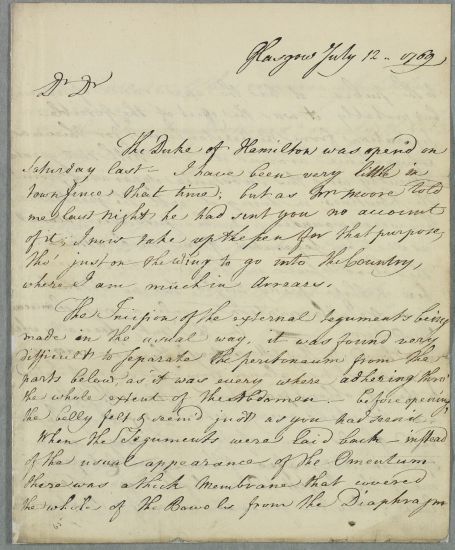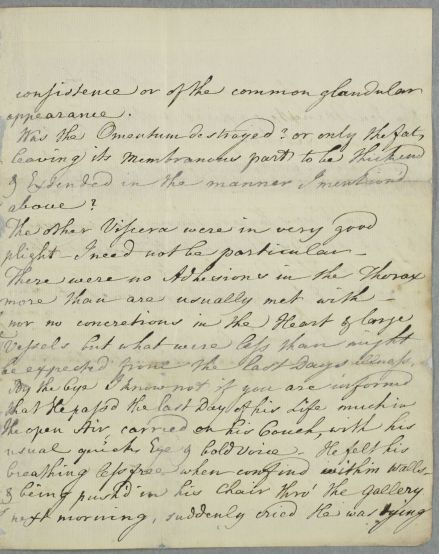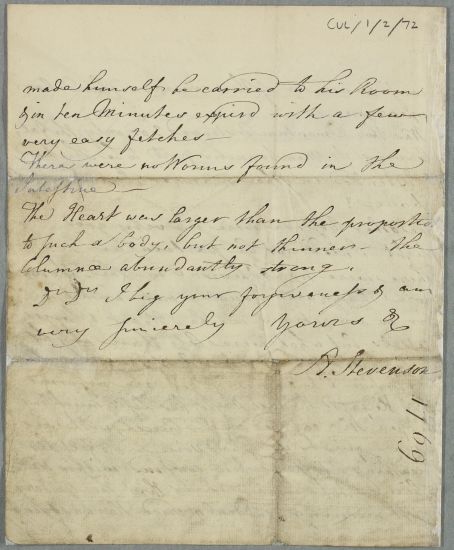
The Consultation Letters of Dr William Cullen (1710-1790) at the Royal College of Physicians of Edinburgh
[ID:803] From: Dr Alexander Stevenson (Professor; of Dalgairn ) / To: Dr William Cullen (Professor Cullen) / Regarding: James Hamilton (7th Duke of Hamilton) (Patient) / 12 July 1769 / (Incoming)
Letter from Alexander Stevenson giving an autopsy report on the young Duke of Hamilton. The post-mortem was performed by the surgeon (poet and writer) John Moore who was attached to the Hamilton household and wrote an epitaph.
- Facsimile
- Normalized Text
- Diplomatic Text
- Metadata
- Case
- People
- Places
Facsimile
There are 4 images for this document.

[Page 1]

[Page 2]

[Page 3]

[Page 4]
Metadata
| Field | Data |
|---|---|
| DOC ID | 803 |
| RCPE Catalogue Number | CUL/1/2/72 |
| Main Language | English |
| Document Direction | Incoming |
| Date | 12 July 1769 |
| Annotation | None |
| Type | Authorial original |
| Enclosure(s) | No enclosure(s) |
| Autopsy | Yes |
| Recipe | No |
| Regimen | No |
| Letter of Introduction | No |
| Case Note | No |
| Summary | Letter from Alexander Stevenson giving an autopsy report on the young Duke of Hamilton. The post-mortem was performed by the surgeon (poet and writer) John Moore who was attached to the Hamilton household and wrote an epitaph. |
| Manuscript Incomplete? | No |
| Evidence of Commercial Posting | No |
Case
Cases that this document belongs to:
| Case ID | Description | Num Docs |
|---|---|---|
| [Case ID:117] |
Case of James Hamilton, 7th Duke of Hamilton, concerning his premature death. |
1 |
People linked to this document
| Person ID | Role in document | Person |
|---|---|---|
| [PERS ID:563] | Author | Dr Alexander Stevenson (Professor; of Dalgairn ) |
| [PERS ID:1] | Addressee | Dr William Cullen (Professor Cullen) |
| [PERS ID:1379] | Patient | James Hamilton (7th Duke of Hamilton) |
| [PERS ID:1] | Patient's Physician / Surgeon / Apothecary | Dr William Cullen (Professor Cullen) |
| [PERS ID:563] | Patient's Physician / Surgeon / Apothecary | Dr Alexander Stevenson (Professor; of Dalgairn ) |
| [PERS ID:769] | Patient's Physician / Surgeon / Apothecary | Dr John Moore |
Places linked to this document
| Role in document | Specific Place | Settlements / Areas | Region | Country | Global Region | Confidence |
|---|---|---|---|---|---|---|
| Place of Writing | Glasgow | Glasgow and West | Scotland | Europe | certain | |
| Destination of Letter | Edinburgh | Edinburgh and East | Scotland | Europe | inferred |
Normalized Text
The Duke of Hamilton was
open'd on
Saturday last - I have been very little in
town since that time; but as Mr Moore told
me last night he had sent you no account
of it; I now take up the pen for that purpose,
tho' just on the wing to go into the Country,
where I am much in Arrears.
The Incision of the external teguments being
made in the usual way, it was found very
difficult to seperate the peritoneum from the
parts below, as it was every where adhering thro'
the whole extant of the Abdomen.-- Before opening,
the belly felt & seem'd just as you had seen it.
When the Teguments were laid back - instead
of the usual appearance of the Omentum
there was a thick Membrane that covered
the whole of the Bowels
from the Diaphragm
[Page 2]
to the pubis - it had the apearance of Erosion,
but probably it was the effect of the forcible
seperation from the peritoneum, for there was
no purulence around it -- With still greater
difficulty was this Substance seperated from
the Intestines; in doing it with the greatest care
they were wounded, & the guts were almost
as ill to be seperated from each other.
The blood vessels on the Intestines were
here & there pretty turgid, but no absolute
sign of Inflammation - only a greyish mucous
Exsudation --- On the gut, especially where
it adhered to the Mesentery, there was a croud
of small whitish glands from the size of Lintseed
to that of oblong pease --- The Mesentery
was thicken'd every where, & full of Indu¬
rated glands - some of them as large as a
Spanish Nut & a few of them were Cut open &
one of the largest had a slight degree of puru¬
lence; they in general were of a Steatomatous
[Page 2]
consistence of the common glandular
appearance.
Was the Omentum destroyed? or only the fat,
leaving its membranous parts to be thickened
& Extended in the manner I mentioned
above?
The other Viscera were in very good
plight - I need not be particular -
There were no Adhesions in the Thorax
more than are usually met with -
nor no concretions in the Heart & large
Vessels but what were less than might
be expected from the last Days illness.
By the bye I know not if you are inform'd
that he passed the last Days of his Life much in
the open Air carried on his Couch, with his
usual quick Eye & bold Voice - He felt his
breathing less free when confined within Walls
& being push'd in his chair thro' the gallery
next morning, suddenly cried He was dying
[Page 3]
made himself be carried to his Room
& in ten minutes expir'd with a few
very easy fetches --
There were no Worms found
in the
Intestine ---
Dear Doctor I beg your forgiveness & am
very sincerely yours &c
Diplomatic Text
The Duke of Hamilton was
open'd on
Saturday last - I have been very little in
town since that time; but as Mr Moore told
me last night he had sent you no account
of it; I now take up the pen for that purpose,
tho' just on the wing to go into the Country,
where I am much in Arrears.
The Incision of the external teguments being
made in the usual way, it was found very
difficult to seperate the peritoneum from the
parts below, as it was every where adhering thro'
the whole extant of the Abdomen.-- Before opening,
the belly felt & seem'd just as you had seen it.
When the Teguments were laid back - instead
of the usual appearance of the Omentum
there was a thick Membrane that covered
the whole of the Bowels
from the Diaphragm
[Page 2]
to the pubis - it had the apearance of Erosion,
but probably it was the effect of the forcible
seperation from the peritoneum, for there was
no purulence around it -- With still greater
difficulty was this Substance seperated from
the Intestines; in doing it with the greatest care
they were wounded, & the guts were almost
as ill to be seperated from each other.
The blood vessels on the Intestines were
here & there pretty turgid, but no absolute
sign of Inflammation - only a greyish mucous
Exsudation --- On the gut, especially where
it adhered to the Mesentery, there was a croud
of small whitish glands from the size of Lintseed
to that of oblong pease --- The Mesentery
was thicken'd every where, & full of Indu¬
rated glands - some of them as large as a
Spanish Nut & a few of them were Cut open &
one of the largest had a slight degree of puru¬
lence; they in general were of a Steatomatous
[Page 2]
consistence of the common glandular
appearance.
Was the Omentum destroyed? or only the fat,
leaving its membranous parts to be thickened
& Extended in the manner I mentioned
above?
The other Viscera were in very good
plight - I need not be particular -
There were no Adhesions in the Thorax
more than are usually met with -
nor no concretions in the Heart & large
Vessels but what were less than might
be expected from the last Days illness.
By the bye I know not if you are inform'd
that he passed the last Days of his Life much in
the open Air carried on his Couch, with his
usual quick Eye & bold Voice - He felt his
breathing less free when confined within Walls
& being push'd in his chair thro' the gallery
next morning, suddenly cried He was dying
[Page 3]
made himself be carried to his Room
& in ten minutes expir'd with a few
very easy fetches --
There were no Worms found
in the
Intestine ---
Dr Dr I beg your forgiveness & am
very sincerely yours &c
XML
XML file not yet available.
Feedback
Send us specfic feeback about this document [DOC ID:803]
Please note that the Cullen Project team have now disbanded but your comments will be logged in our system and we will look at them one day...


